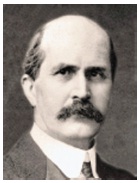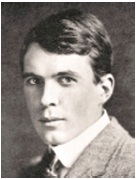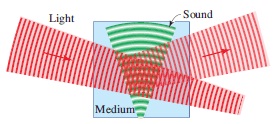Chapter 20 ACOUSTO-OPTICS
- 20.1 INTERACTION OF LIGHT AND SOUND
- 20.2 ACOUSTO-OPTIC DEVICES
- *20.3 ACOUSTO-OPTICS OF ANISOTROPIC MEDIA


Sir William Henry Bragg (1862–1942, left) and Sir William Lawrence Bragg (1890–1971, right), a father-and-son team, were awarded the Nobel Prize in 1915 for their studies of the diffraction of light from periodic structures such as those created by sound.
The refractive index of an optical medium can be altered by the presence of sound. Acousto-optics is the study of how sound modifies the effect such a medium has on light, as schematically illustrated in Fig. 20.0-1. Many useful photonic devices make use of the ability of sound to control light; these include optical modulators, switches, deflectors, filters, isolators, frequency shifters, and spectrum analyzers.

Figure 20.0-1 Sound can modify the effect of an optical medium on light.
Sound is a dynamic strain involving molecular vibrations that takes the form of a wave traveling at a velocity characteristic of the medium ...
Get Fundamentals of Photonics, 2 Volume Set, 3rd Edition now with the O’Reilly learning platform.
O’Reilly members experience books, live events, courses curated by job role, and more from O’Reilly and nearly 200 top publishers.

